Types of connection of radiators: serial, parallel,
Probably, you should immediately pay attention to the fact that a direct connection of a heating radiator implies three main options - side, bottom and diagonal, but some nuances are possible. In addition, there are options for contours, which can be one-pipe or two-pipe, it also depends on the number of floors in the building, and can also be considered from the point of view of design. But we will talk more about all this in the material below, and we will also show you on the topic of the video in this article.

Ways to connect differently
Variety of contours
Note. The heating system circuit can be either one-pipe or two-pipe. The efficiency of heat transfer of devices, as well as methods for their connection, depends on this.

- A single-pipe heating system implies a looped loop from a single pipe into which heating radiators are slammed - an example of this installation is shown in the upper image:
- here the coolant, moving from the boiler, on the way, through pipes of a smaller diameter, diverges through the batteries and under the pressure of the circulation pump returns back to the same pipe;
- but after passing through the heater, the water loses temperature, therefore, the more radiators in such a system, the colder the water will be at its end;
- in autonomous systems, it is not recommended to install more than 3-4 radiators on one looped pipe in order to be able to maintain approximately the same temperature in each of them;
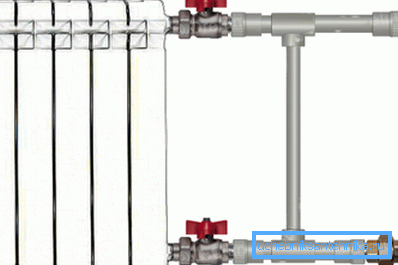
- In a one-pipe system, especially in multi-storey buildings, it is more convenient to connect devices from the side, but how to connect a heating radiator with a side connection in order to preserve the temperature in subsequent batteries as much as possible? To do this, a jumper, called a “bypass”, cuts between the supply and return pipes and serves two purposes:
- first, some of the water passes through the pipe without getting into the battery, therefore, it is not cooled;
- secondly, thanks to the bypass, you can dismantle without draining the coolant, even if the circuit passes directly through the radiator without a bypass;
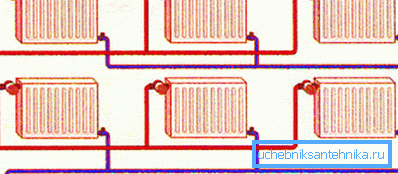
- The two-pipe circuit can be called more convenient - here the coolant enters the radiator from the supply pipe, and the cooled water is discharged into the return pipe and returns to the boiler for new heating:
- But the cost of operating such an arrangement is somewhat higher, since you have to heat more water, therefore, you need to spend more energy to pay;
- But such a circuit never causes problems and you can embed a large number of radiators into it, since it is possible to maintain a uniform temperature in all;
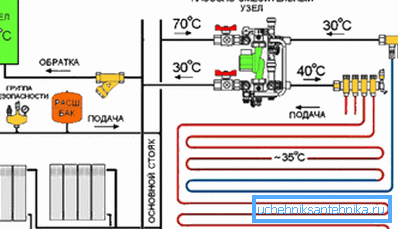
- In addition, for a two-pipe system, the instruction provides for the joint connection of a radiator circuit with a warm floor, but these are two different devices that require the circulation of coolant at different temperatures.
- But, despite this apparent disagreement, such a connection takes place - a three-way valve working on a discrete system is installed at the entrance to the floor heating pipe, and when the circuit heats up to the desired state, the valve is activated and the hot water from the feed is reset to “return”;
- The principle of such a connection is well shown in the schematic image above this paragraph.
Sequentially and in parallel
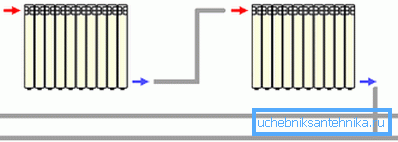
In addition, the connection can be serial and parallel, so the serial connection of radiators is shown in the upper image.
This situation also arises when the bypass is blocked and water from one radiator immediately flows into the other, bypassing the supply and return flow. But it is not at all necessary that the circulation be diagonally across the device - so it can be a lower side connection (“Leningrad”) or a unilateral side connection, the point is that the heat transfer fluid immediately flows from the battery to the battery.

When the connection of heating radiators is parallel, they are independent of each other, therefore, the water temperature in them will be uniform, both in the first and in the last device.
But this is possible only in a two-pipe system, where the quantity of batteries does not affect the flow of coolant in any way. The diagram of such a connection you see at the top, and it can be side, bottom or diagonal.
Diagonal, side and bottom

The diagonal connection of radiators is considered optimal, because the coolant circulates in it with the greatest uniformity, so when you see the nominal power in the accompanying documents, the manufacturer proceeds from this type of connection when the entire area of the device is used equally.
It is believed that here the loss of maximum power does not exist, and it is issued at 100%. There is another auxiliary option when you can optimally use the entire capacity, but this is slightly lower.
The heating device works somewhat worse (only at 95% of the rated power), if it is connected from the side (on one side or on both sides) - here the heating area will be more intense on the supply side.
But with a lower connection, which is also called a “Leningrad”, the nominal efficiency is only 90%, since the circulation is hampered by high pressure and, naturally, the heating area here is the most uneven.
Note. Before you start calculating the power for the heaters in your apartment or private house, you should finally determine the method of connecting radiators. Only in this case will you be able to calculate the number of sections most correctly.
Extender duct as a heat distribution optimizer

It is not always possible to connect batteries diagonally in an autonomous or centralized heating system in order to ensure maximum (100%) heat output, and there are various reasons for this - there are both technical capabilities and features of the interior or simply the human factor - have you lost sight of or not knew.
When there are not many sections, in any case, no more than 8-10 pieces, or even fewer, then temperature drops in the total area of the radiator are not noticeable, and if they are noticeable, then not much. But if the number of sections is increased, and such a need arises quite often, then temperature drops at different ends of the same device can reach 10 ° C and even more.
Of course, you can reconnect, that is, connect the device diagonally and in this case, the coolant will be evenly distributed over the entire area, but this is not always possible due to the same technical conditions or interior features.
In such situations, there is a kind of panacea - it is a duct extender, which for some reason, for some reason, is very difficult to find in our stores selling sanitary ware, but it can be done independently.
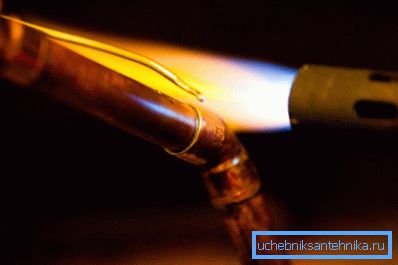
To do this, you will need a copper pipe with an outer diameter of 18 mm and a wall thickness of at least 1 mm, as well as a copper coupling for soldering (adapter to the fitting) with an outer diameter of 19.5 mm.
The length of the pipe is calculated taking into account the number of sections, so its end should reach the junction of the last and penultimate section - in some cases, the extension cable is made to the middle of the radiator, but you can cut the pipe at any time. We will not describe the soldering process in all details, let us just say that the flux should not get inside the pipe, that is, there should not be much of it, since a frozen drop can form and the water during the circulation will make noise.

The duct extender is installed in the upper part of the radiator, but it is better, of course, to use it together with a thermal head, with which you can set the temperature you need. But the distribution of the coolant in the area of the battery you will now be uniform.
Conclusion
You can also connect radiators with your own hands, if, of course, you have the necessary tools for this. But if you are a beginner in this business, then do not forget that this is quite responsible - the leakage of the system during the heating season is not just an unpleasant phenomenon, but, one might say, out of the ordinary. Therefore, if you do not rely on your strength, then it is better to invite a specialist.